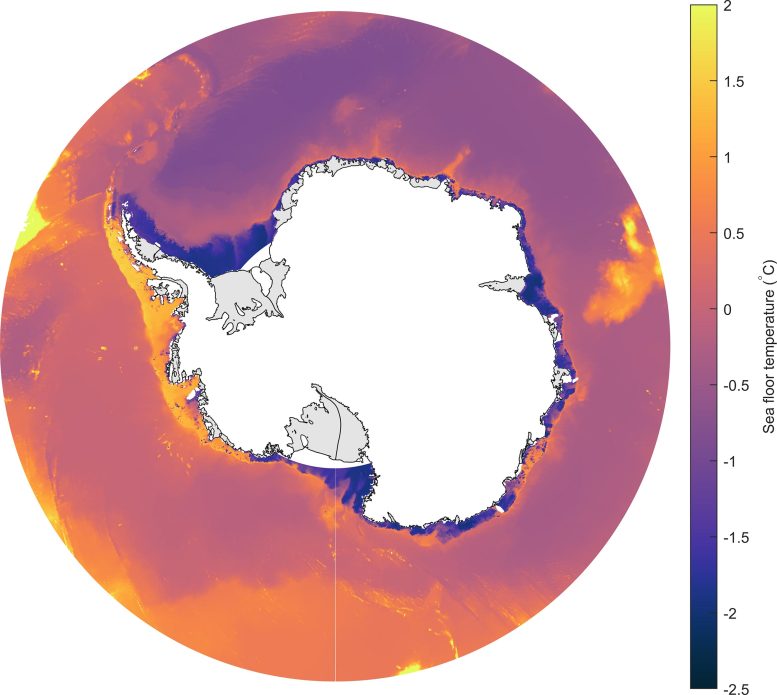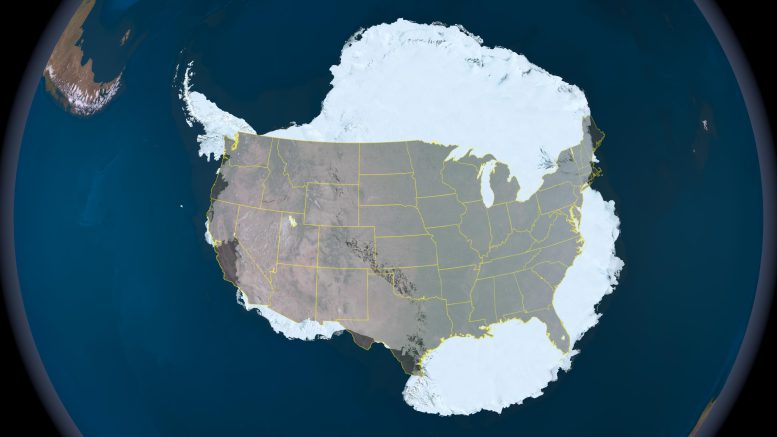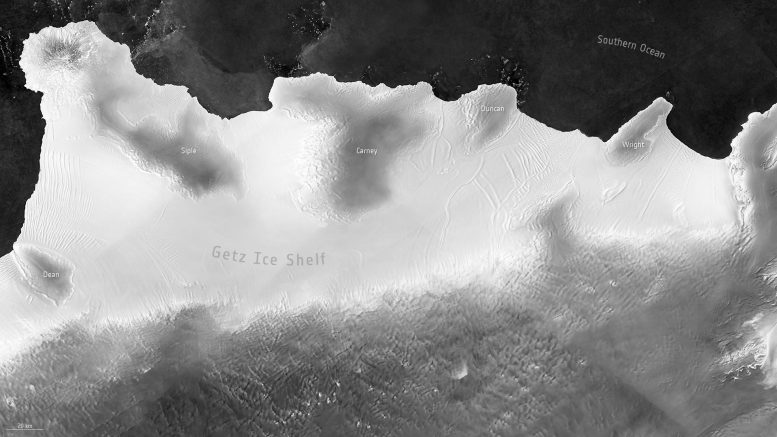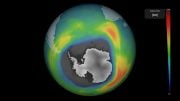
The graphic shows the water temperatures around the Antarctic. On the western side of Antarctica, water temperature at the sea floor is approaching 2 degrees C — and that is warm enough to melt the ice that is flowing on top of it. Sea temperatures on the eastern flank are colder. Credit: Dr. Benjamin Davison/University of Leeds.
Over 40 percent of Antarctica’s ice shelves reduced in volume over 25 years.
- Thinning ice shelves release a vast quantity of freshwater into the oceans
- Ice shelves on the western side of Antarctica most impacted
- Human-induced global warming a likely cause
71 of the 162 ice shelves that surround Antarctica have reduced in volume over 25 years from 1997 to 2021, with a net release of 7.5 trillion tonnes of meltwater into the oceans, say scientists.
They found that almost all the ice shelves on the western side of Antarctica experienced ice loss. In contrast, most of the ice shelves on the eastern side stayed the same or increased in volume.
Over the 25 years, the scientists calculated almost 67 trillion tonnes of ice was exported to the ocean, which was offset by 59 trillion tonnes of ice being added to the ice shelves, giving a net loss of 7.5 trillion tonnes.
The video animation shows what has happened to ice around the Antarctic over the last 25 years – and summarizes the findings of this research project. Credit: Planetary Visions/European Space Agency
Dr. Benjamin Davison, a research fellow at the University of Leeds who led the study, said: “There is a mixed picture of ice-shelf deterioration, and this is to do with the ocean temperature and ocean currents around Antarctica.
“The western half is exposed to warm water, which can rapidly erode the ice shelves from below, whereas much of East Antarctica is currently protected from nearby warm water by a band of cold water at the coast.”
Geographical and Climate Differences
Antarctica is a vast continent — 50 times the size of the UK — and the seas on the western side experience different currents and winds than on the east, and this is driving warmer water underneath the ice shelves on the western flank.
Dr. Davison, an expert in Earth Observation of polar regions in the School of Earth and Environment, said: “We expected most ice shelves to go through cycles of rapid, but short-lived shrinking, then to regrow slowly. Instead, we see that almost half of them are shrinking with no sign of recovery.”

The total surface area of Antarctica is about 14.2 million sq km (about 5.5 million sq miles) in summer, much larger than the continental United States, approximately twice the size of Australia, and fifty times the size of the UK. Antarctica is the highest, driest, coldest, windiest, and brightest of the seven continents. It is completely covered by a layer of ice that averages more than one mile in thickness, but is nearly three miles thick in places. This ice accumulated over millions of years through snowfall. Presently, the Antarctic ice sheet contains 90% of the ice on Earth and would raise sea levels worldwide by over 200 feet were it to melt. Credit: NASA/Goddard Space Flight Center Scientific Visualization StudioLIMA Data provided by: Patricia Vornberger (SAIC)LIMA data produced by U.S. Geological Survey (USGS), the British Antarctic Survey (BAS) and NASA
He believes human-induced global warming is likely to be a key factor in the loss of the ice. If it was due to natural variation in climate patterns, there would have been some signs of ice regrowth on the western ice shelves.
Ice shelves float on the seas surrounding Antarctica and are extensions to the ice sheet that covers much of the continent. The ice shelves act as giant “plugs” at the end of glaciers, slowing down the flow of ice draining into the oceans.
When the ice shelves thin or reduce in size, these plugs weaken with the result that the rate of ice lost from the glaciers increases.
Getz Ice Shelf
Some of the biggest ice losses were observed on the Getz Ice Shelf, where 1.9 trillion tonnes of ice were lost over the 25-year study period. Just 5 % of that was due to calving, where large chunks of ice break away from the shelf and move into the ocean. The rest was due to melting at the base of the ice shelf.

A satellite image showing the Getz ice shelf. Getz lost 1.9 trillion tonnes of ice over the 25-year study period. The image is a composite made from satellite data recorded between January and September 2023. Credit: European Space Agency
Similarly, on the Pine Island Ice Shelf, 1.3 trillion tonnes of ice were lost. Around a third of that loss — 450 billion tonnes — was due to calving. The rest is due to melting from the underside of the ice shelf.
In contrast, the Amery Ice Shelf — on the other side of Antarctica — gained 1.2 trillion tonnes of ice. It is surrounded by much colder waters.
Major Assessment of Antarctica
The researchers analyzed over 100,000 satellite radar images to produce this major assessment of the “state of the health” of the ice shelves.
If the ice shelves disappear or even diminish, there will be major knock-on effects for the ice system on Antarctica and for global ocean circulation, the giant “conveyor belt” which moves nutrients as well as heat and carbon from this sensitive polar ecosystem.
Potential Disruption to Ocean Circulation
Water released into the ocean from the ice shelves and from the glaciers is freshwater. Over the 25-year study period, the researchers estimated that 66.9 trillion tonnes of freshwater went into the Southern Ocean around Antarctica from the ice shelves alone.
In the Southern Ocean, dense salty water sinks to the ocean floor as part of the global ocean conveyor belt. This sinking of water acts as one of the engines that drive the ocean conveyor belt.
Freshwater from Antarctica dilutes the salty ocean water, making it fresher and lighter, which takes longer to sink and this can weaken the ocean circulation system
A different study, published in the journal Nature Climate Change, shows that this process may already be underway.
‘Steady Attrition’
Professor Anna Hogg, also from the University of Leeds and a co-author of the study, said: “The study has generated important findings. We tend to think of ice shelves as going through cyclical advances and retreats. Instead, we are seeing a steady attrition due to melting and calving.
“Many of the ice shelves have deteriorated a lot: 48 lost more than 30% of their initial mass over just 25 years.
“This is further evidence that Antarctica is changing because the climate is warming.
“The study provides a baseline measure from which we can see further changes that may emerge as the climate gets warmer.”
Satellite Monitoring
Information about what is happening in Antarctica in recent years has largely come from the CryoSat-2 and Sentinel-1 satellites, which can monitor Antarctica even when it is cloudy and through the long polar nights.
CryoSat-2, launched in 2010, was the first European Space Agency Explorer mission and the first dedicated to monitoring the Earth’s polar ice sheets and glaciers.
Professor Noel Gourmelen, from the University of Edinburgh and Earthwave and co-author of the study, said: “CryoSat-2 has been an incredible tool for monitoring the polar environment. Its ability to precisely map the erosion of ice shelves by the ocean below enabled this accurate quantification and partitioning of ice shelf loss, but also revealed fascinating details on how this erosion takes place.”
Details captured by these satellite sensors are so great scientists have been able to track year-by-year changes in Antarctica.
Dr. Mark Drinkwater, Head of Earth and Mission Science at the European Space Agency (ESA), said: “Monitoring and tracking climate change across the vast Antarctic continent requires a satellite system that captures data routinely throughout the year.
“The European Copernicus Programme’s Sentinel-1 satellite mission has fulfilled this need. Together with the historical data acquired by its ESA predecessors ERS-1, -2, and Envisat, Sentinel-1 has revolutionized our ability to take stock of floating ice shelves, as a bellwether for mass balance and the health of the Antarctic ice sheet.
“In the near future, we will further augment Antarctic monitoring with three new polar-focused missions CRISTAL, CIMR, and ROSE-L.
Reference: “Annual mass budget of Antarctic ice shelves from 1997 to 2021” by Benjamin J. Davison, Anna E. Hogg, Noel Gourmelen, Livia Jakob, Jan Wuite, Thomas Nagler, Chad A. Greene, Julia Andreasen and Marcus E. Engdahl, 12 October 2023, Science Advances.
DOI: 10.1126/sciadv.adi0186









“Human-induced global warming a likely cause”
Then why is the melting not uniform around Antarctica? Why is there no mention of the under-ice volcanoes in western Antarctica? https://www.pbs.org/newshour/science/scientists-found-91-volcanoes-under-antarctica
“The ice shelves act as giant “plugs” at the end of glaciers, slowing down the flow of ice draining into the oceans.”
When sea water freezes onto the snout of a glacier, the new ice inherits the momentum of the glacier. Thus, it will take some significant force to impede it — greater than the ice-to-rock friction of the glacier still on land. Sometimes that comes in the form of the shelf ice or glacier encountering an underwater ridge or old terminal moraine. That means it is megatons of rock, not shelf ice, that is impeding the glacier ice. I think that the glaciologists need to go back and examine their basic assumptions about the behavior of the shelf ice.
“Human-induced global warming a likely cause” That means CO2. So, how can CO2 being emitted mostly in the Northern hemisphere induce the melting ice from below in Antarctica? More importantly, what possible action could humans take that might stop it. Lowering CO2 emissions will not take any of the CO2 already added out. And industrial CO2 capture and storage cannot take enough out to matter. Maybe it’s time to get realistic and start to improve infrastructures and adapt?